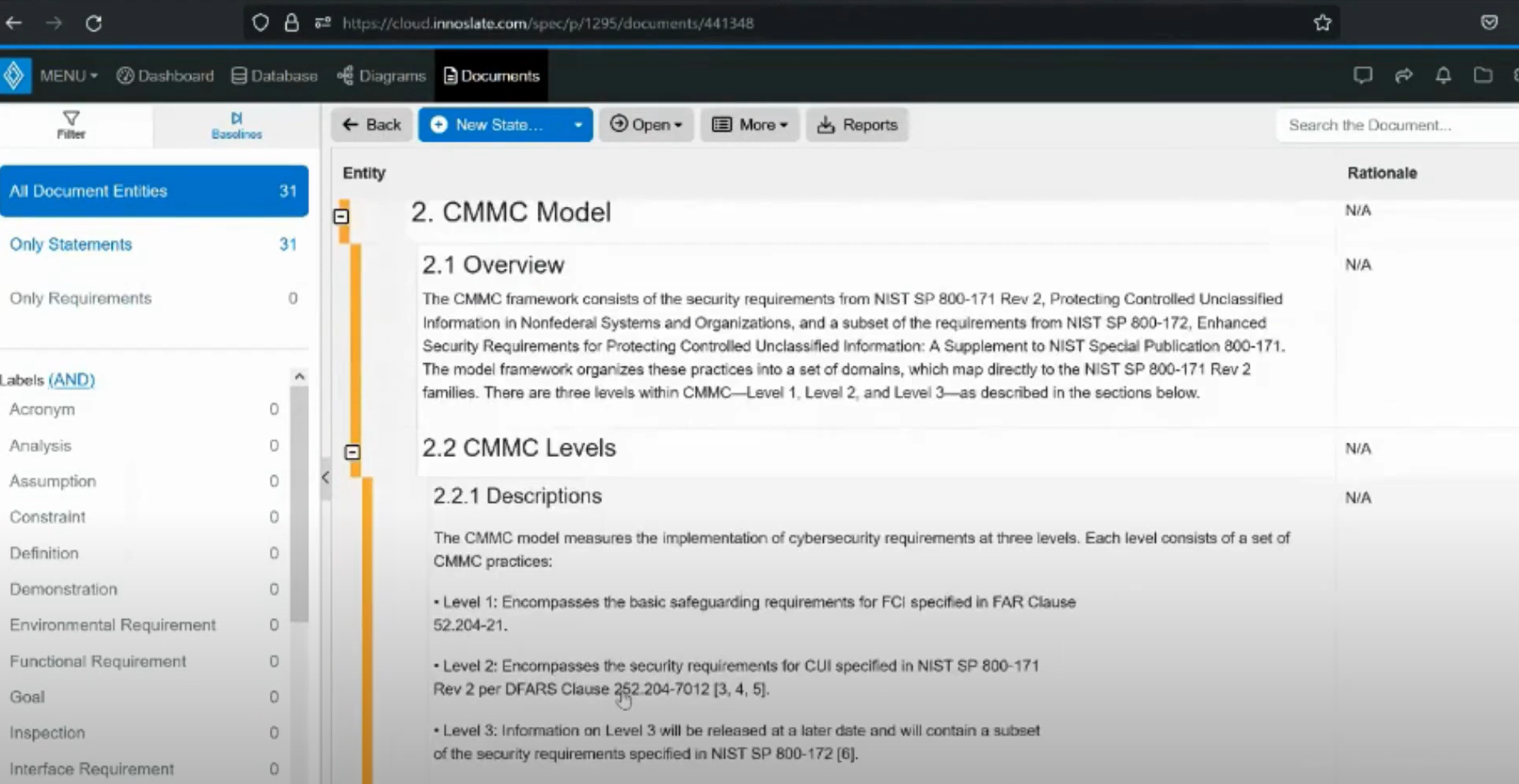Introduction
In today's interconnected and data-driven world, cybersecurity is a top priority for businesses, government agencies, and organizations of all sizes. The increasing frequency and sophistication of cyberattacks demand comprehensive solutions to protect sensitive data and infrastructure.
Innoslate, our powerful systems engineering and requirements management platform, has emerged as a game-changer in the realm of cybersecurity. In this blog, we will explore the exceptional cybersecurity capabilities that Innoslate offers, helping organizations fortify their defenses against cyber threats.
Understanding Innoslate
Innoslate is an all-in-one platform designed to manage the entire systems engineering lifecycle, from requirements analysis to verification & validation. This cloud-based tool is trusted by organizations across various industries, including aerospace, defense, healthcare, and more. Innoslate helps streamline complex processes, enhance collaboration, and reduce development time and costs.
Innoslate's Cybersecurity Capabilities
- Compliance and Reporting: Compliance with industry standards and regulations is crucial for cybersecurity, including FedRAMP, CMMC 2.0, and STIG.
Our developers work tirelessly to provide the most secure environment possible in the world of cloud computing. We chose the Amazon Web Services (AWS) cloud platforms (both the regular AWS cloud and GovCloud) for this reason. The AWS cloud has been FedRAMP certified and has IL 4 and higher protection options, all the way to IL 7. We communicate with AWS through https, which means the data between the user and AWS is encrypted in transit. AWS then encrypts the data at rest.
Since Innoslate® uses SQL databases as its foundation, all the security controls available for database management systems, such as the popular Microsoft SQL Server, are available to the users. These Database Management System tools can add many other security controls. We also support various single sign-on capabilities, including LDAP, CAC, OAUTH, and SAML. These features along with other features we won’t discuss ensure hackers are up against as hard of a target as possible.
Since Innoslate joined Iron Bank, a collection of software that has been approved and hardened for use across the entire DoD, we are required to meet those stringent security requirements. This causes us to consistently update libraries and improve the containerization of the tool.
In addition to Iron Bank, SPEC Innovations received a Security Technical Implementation Guide (STIG) approval from the Defense Information Systems Agency (DISA). The culmination of this two-year process means that Innoslate® meets the stringent security requirements of the Department of Defense and the guide provides a means to securely install Innoslate® on any DoD system.
Innoslate also offers templates (NIST 800-171r2, ISO-27001, etc.) and tools to help organizations align with compliance requirements, streamlining the process of preparing for audits and reporting on security measures.

- Security Requirements Management: Cybersecurity begins with clearly defined security requirements. Innoslate allows users to document, manage, and trace these requirements throughout the development lifecycle. This ensures that security considerations are integrated into the earliest stages of a project, reducing the risk of overlooking critical elements.
- Threat Modeling: Innoslate facilitates threat modeling, a crucial practice for identifying vulnerabilities and potential attack vectors. Teams can create threat models, assess risks, and plan mitigations all within the platform. This comprehensive approach enhances an organization's proactive stance against potential cyber threats.
- Vulnerability Analysis and Risk Assessment: Innoslate enables users to perform vulnerability assessments and risk analyses. By conducting comprehensive security assessments, organizations can identify weak points in their systems and prioritize security improvements based on risk severity.
- Traceability and Impact Analysis: The platform provides advanced traceability features, which are invaluable in cybersecurity. Users can track relationships between security requirements, threats, and vulnerabilities, ensuring that security measures align with potential risks.
- Collaboration and Communication: Effective communication is pivotal in cybersecurity. Innoslate promotes collaboration among teams and stakeholders by offering a shared workspace for discussing security issues, tracking progress, and making informed decisions.
- Change Management: Cybersecurity landscapes evolve rapidly, and Innoslate assists in managing changes to security requirements and policies. Organizations can adapt to emerging threats efficiently and ensure that their systems remain secure.
- Security Testing Integration: Innoslate integrates with various security testing tools, allowing organizations to conduct penetration tests, vulnerability scans, and other security assessments. This integration streamlines the process of identifying and addressing security weaknesses.
- Incident Response Planning: Innoslate can be used to develop and maintain incident response plans. In the event of a security breach, having a well-defined plan in place is critical for minimizing damage and recovering swiftly.
- Continuous Improvement: The cybersecurity landscape is ever-changing. Innoslate supports continuous improvement by providing data-driven insights that help organizations refine their security practices and stay ahead of emerging threats.
Conclusion
Innoslate's cybersecurity capabilities make it a valuable tool for organizations looking to fortify their digital defenses. By offering comprehensive features for security requirements management, threat modeling, vulnerability assessment, and more, Innoslate empowers organizations to proactively address cyber threats. In an era where data breaches and cyberattacks are all too common, having a versatile platform like Innoslate can mean the difference between staying secure and becoming a victim of cybercrime.
SPEC Innovations Team
:
10/30/23 11:53 AM



.png)
.png)